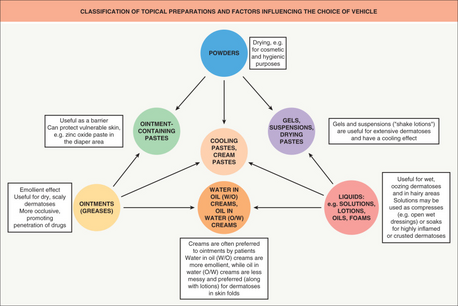Jump to content
Principles of Topical Therapy
- Unilateral treatment allows for easier treatment response evaluation than with systemic treatment
- Topical preparations/formulations consist of a drug in a non-active base/vehicle
- Drugs used on skin must be dissolved or suspended in a vehicle
- The choice of drug depends on the diagnosis
- The choice of vehicle depends on the state of the skin
- The drug will be transferred from the vehicle to stratum corneum
- The base determines the rate at which the drug is absorbed through the skin
 An overview of different types of topical formulations. From https://plasticsurgerykey.com/other-topical-medications-2/Vehicles
An overview of different types of topical formulations. From https://plasticsurgerykey.com/other-topical-medications-2/Vehicles
- Liquid vehicles
- Solid vehicles (powders)
- Zinc oxide
- Titanium oxide
- Talc
- Starch
- Fatty vehicles (greases)
- Vegetable fats
- Animal fats
- Mineral oils
- Petrolatum
- Types of topical preparations
- Topical preparations
- Solution
- Drug dissolved in a liquid solvent like alcohol or water
- Convenient to apply (can be applied with a dropper)
- Lotions
- Water-based emulsion
- Thicker than solution
- Good for hairy skin
- They cool inflammatory lesions and dry exudative lesions
- Creams
- A semisolid emulsion of water in oil or oil in water
- Thicker than lotion
- Good for weeping lesions
- When applied with wet compress -> good for inflamed skin
- Ointments
- Semisolid grease or oil, without water
- Good for scaly or dry lesions
- When applied with wet compress -> good for inflamed skin
- Gels
- Soft, semisolid preparation
- Liquefy on contact with the skin
- Foam
- Aerosolized solution with a pressurized propellant
- Good for hairy skin
- Powders
- Solid
- For lesions in moist or intertriginous areas
- Cooling paste
- Contains oil, water and powder
- Often contains zinc oxide
- Cools inflamed skin
- Dressings
- Protect open lesions, facilitate healing, increase drug absorption
- Non-occlusive dressings (wet dressings)
- Dressings wetted with saline or water
- Applied to the lesion and removed when the solution has evaporated
- Good for thick or crusted lesions
- Good for oozing lesions
- Occlusive dressings
- Increase the absorption and effectiveness of topical therapy
- Can be applied over topical preparations to increase absorption
- Can be applied to open wounds to allow them to heal
- Moisturizing agents (emollients)
- Restore water and oil to skin and help maintain skin hydration
- More effective in slightly wet skin, like after a shower
- Available as lotions, creams, ointments, etc.
- Indicated in dry skin conditions
- Contains occlusives and humectants
- Humectants
- These agents attract water, increasing the water-holding capacity of the stratum corneum
- Glycerine
- Urea
- Lactic acid
- Glycolic acid
- Occlusives
- Form a physical barrier to prevent water loss
- Waxes
- Petrolatum
- Oils
- Drying agents (powders)
- To treat excessive moisture, like between skin folds, the groin, etc
- Corn starch
- Talc
- Topical agents to alleviate pruritus
- Pramoxine
- Hydrocortisone
- Menthol
- Phenol
- Keratolytics
- These agents facilitate exfoliation of epidermal cells
- Used to treat hyperkeratotic diseases like
- Psoriasis
- Seborrheic dermatitis
- Acne
- Urea
- Salicylic acid
- Lactic acid
- Glycolic acid
- Steroids
- Widely used in dermatology
- Indications
- Cutaneous lupus erythematosus
- Psoriasis
- Lichen
- Contact dermatitis
- Atopic dermatitis
- Allergic skin reactions
- Mostly used steroids
- Hydrocortisone (low potency)
- Triamcinolone (medium potency)
- Clobetasol (high potency)
- Side effects
- Skin atrophy
- “Steroid acne”
- Striae
- Contact allergy
- “Steroid rosacea” = perioral dermatitis
- When potent steroids are used on the face
- Telangiectasias
- Papules, pustules
- Topical antibiotics
- Mostly used in acne
- Tetracyclines
- Metronidazole
- Erythromycin
- Clindamycin
- Bacitracin
- Silver nitrate
- Low concentration – debride wounds
- High concentration – cauterizes bleedings in wounds
- Imiquimod
- Immune regulator
- Indications
- Warts
- BCC
- Actinic keratosis
- Topical calcineurin inhibitors
- Tacrolimus
- Pimecrolimus
- Indications
- 5-fluorouracil
- Indications
- Actinic keratosis
- BCC
- Warts
- Fingertip units (FTU)
- 1 FTU = the amount of topical preparation expressed from a tube when applied from the distal skin-crease to the tip of the index finger
- 1 FTU is approx. 0,5 g
- 1 FTU covers approx. 300 cm2, which is enough for one hand
- 2,5 FTU covers the face and neck
- Fingertip units are useful when telling patients how much they should use of a preparation

